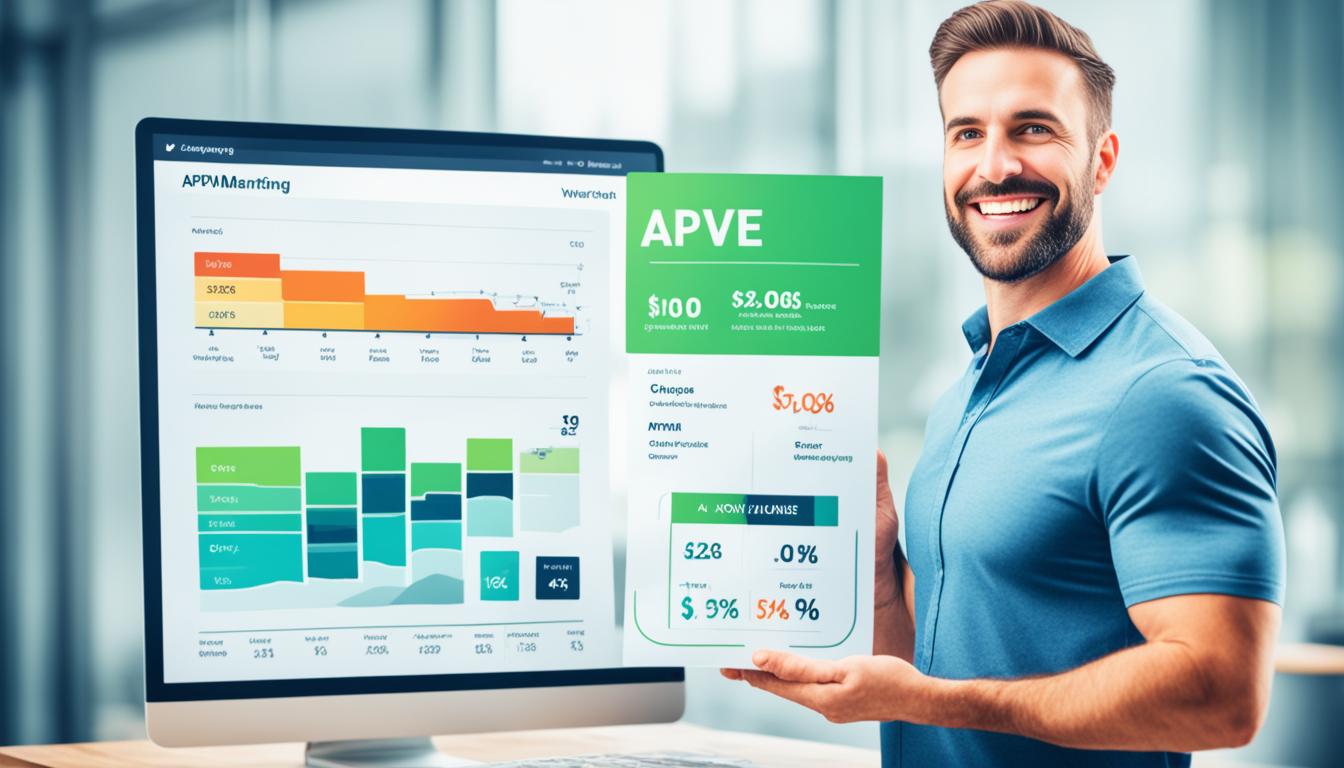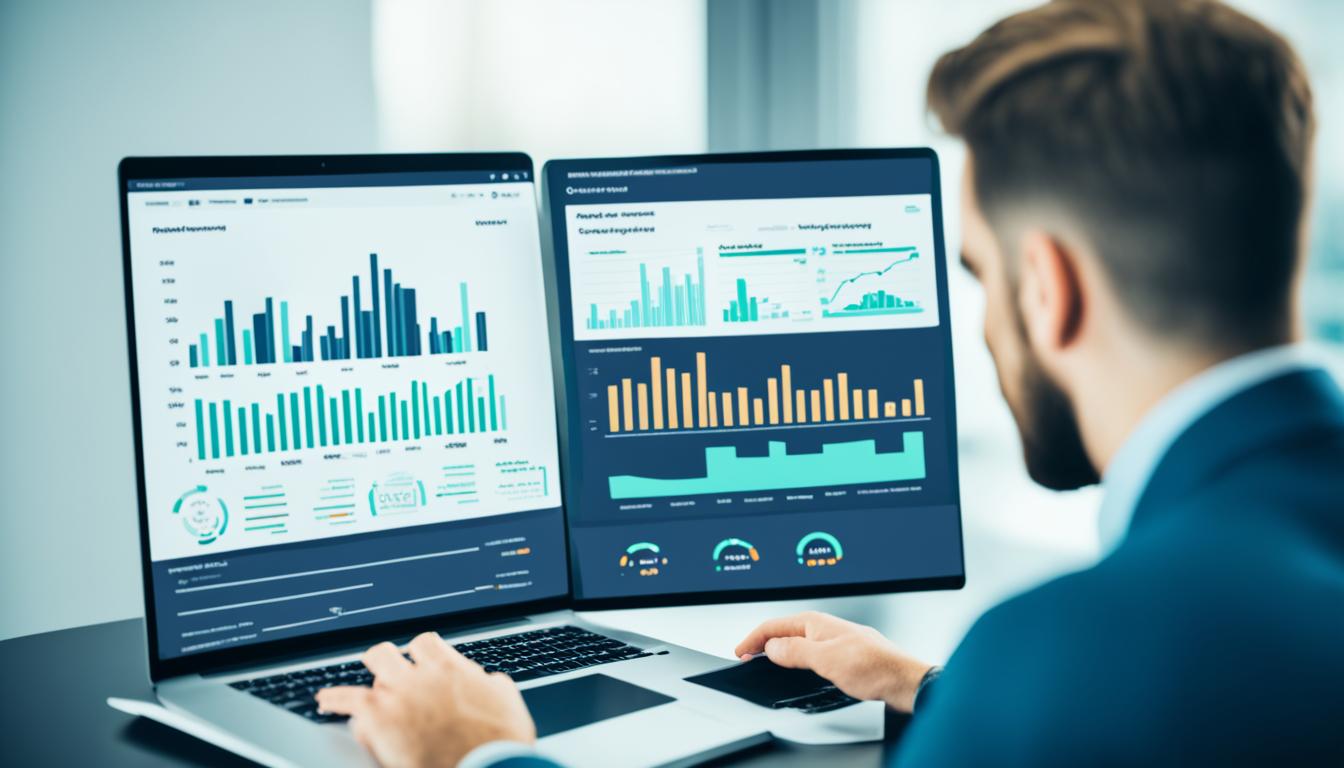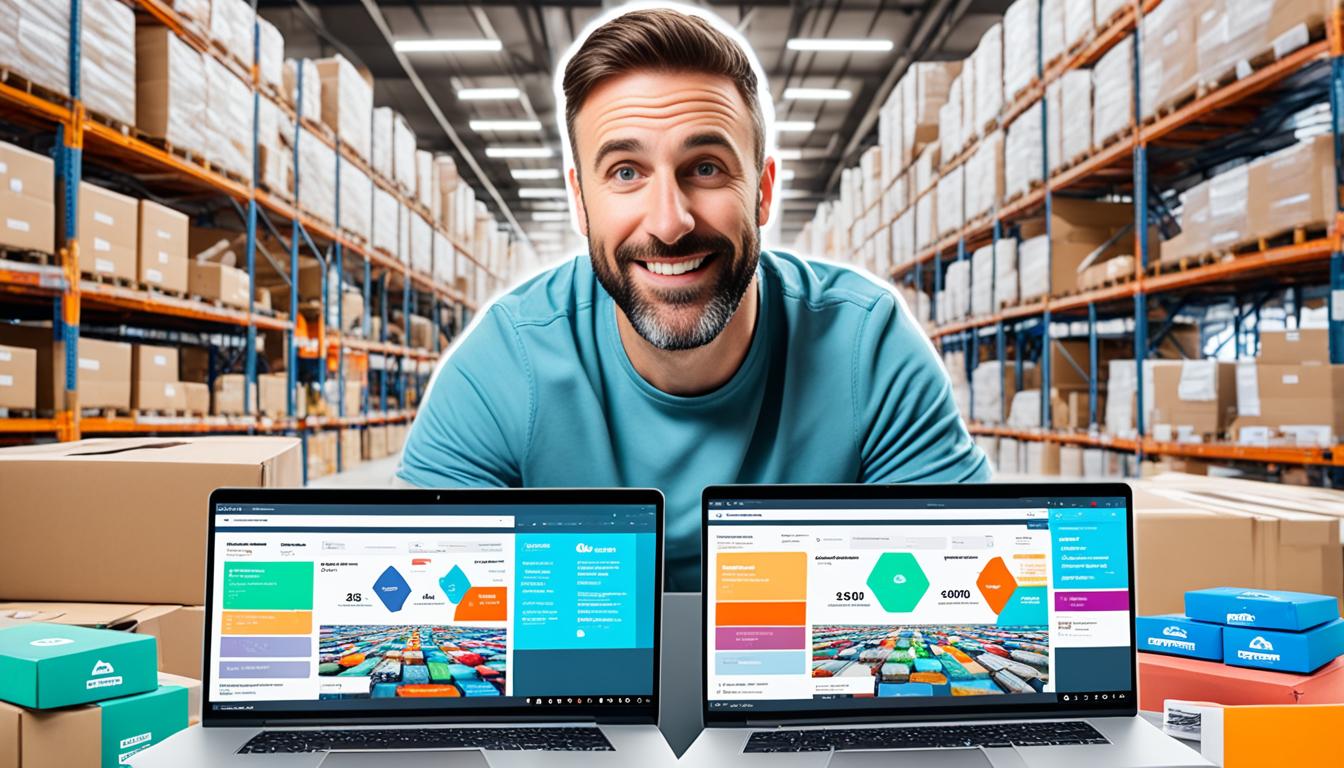Beacon marketing is a key player in today’s shopping scene. It uses beacon tech to reach customers exactly where they are. Shops can send out special offers and news directly to shoppers’ phones. This makes shopping more personal and boosts sales.
It’s become a big deal with the rise of mobile and location tech. Brands can now touch base with people on the go. They send ads and experiences that fit what customers like and need.
Key Takeaways:
- Beacon marketing uses beacon technology to target customers in specific locations.
- Bluetooth beacons communicate with customers’ smartphones to deliver personalized messages.
- Beacon marketing offers tailored experiences, targeted advertising, and valuable customer insights.
- Examples of beacon marketing in retail include promotional offers, product availability notifications, and location-based information.
- While beacon marketing has challenges, its future looks promising in enhancing customer engagement.
What is Beacon Marketing?
Beacon marketing uses small devices to send special offers to customers based on where they are. These devices, or beacons, are set up in places like stores. They make shopping more personal and enjoyable. By sending messages that match what customers like, beacon marketing boosts sales and improves shopping.
Beacons use Bluetooth to notice when a customer is nearby. They then send a message or offer to the customer’s phone. This means businesses can talk to customers right away. They can give useful info and great deals based on where the customer is in the store.
Beacon marketing is all about giving customers what they want. It sends deals and messages that match their interests. This makes it more likely for customers to buy things. It also makes them want to come back. Customers enjoy getting offers that matter to them while they shop.
Also, beacon marketing helps businesses understand what customers like. By seeing how customers react, businesses can learn more about them. This knowledge helps businesses improve their marketing and make shoppers happier.
For beacon marketing to work well, businesses need to plan. They have to choose the best spots for the beacons and create offers that grab attention. It’s important to keep checking how well the campaigns are doing. This helps businesses get better over time.
In the next section, we will explore how beacon marketing works and the technology behind it.
How Beacon Marketing Works
Beacon marketing uses Bluetooth to connect with customers’ smartphones. When they come near a beacon, it sends a Bluetooth signal. This triggers personalized messages or offers based on where they are and what they like.
This type of marketing doesn’t need internet. This makes it easy and reliable for engaging customers in real places. Using Bluetooth beacons, businesses can send messages that really matter to their customers. This makes shopping better for everyone.
Imagine a customer walking into a store and passing a beacon near the entrance. The beacon connects with their phone via Bluetooth. Then, they get a special message or offer, inviting them to check out the store or learn about promotions.
This way, businesses can make their messages fit what each customer likes and has done before. They can tell customers about special deals, new products, or rewards for coming back. Beacon marketing lets businesses talk to customers in a way that’s right for them.
One of the best things about beacon marketing is sending messages right when it matters. This means businesses can talk to customers exactly when they’re nearby. Getting a message at the right time makes customers more likely to buy right away.
Benefits of Beacon Marketing:
- Delivers personalized messages and offers
- Enhances customer engagement and satisfaction
- Increases sales and conversion rates
- Provides valuable insights into customer behavior and preferences
- Creates a seamless and tailored shopping experience
To use beacon marketing, businesses must place beacons around and have an app to talk to them. Becons can be placed in many places, like by doors, near special products, or where people spend a lot of time.
Overall, beacon marketing uses Bluetooth to give customers a personal and easy shopping experience. By sending the right messages at the right time, businesses can connect better, boost sales, and stand out from others.
Benefits of Beacon Marketing
Beacon marketing gives businesses many benefits. It uses new tech to offer customers personalized experiences. This builds deeper relationships and boosts engagement.
Targeted advertising is a big plus of beacon marketing. Businesses can send specific messages and deals based on where customers are. This makes ads more relevant, increasing sales chances.
Beacon marketing also allows for personalization on a big scale. Messages and suggestions can go straight to customers’ phones. This makes shopping more personalized, improving satisfaction and loyalty.
Beacon marketing offers rich customer data, too. By looking at data from beacon interactions, businesses learn about customer habits and likes. They use these insights to make better decisions and strategies.
In short, beacon marketing lets businesses offer custom experiences and better advertising. It also provides personalized messaging and key customer data. By using this tech, businesses can outdo competitors, increase sales, and engage customers better.
Examples of Beacon Marketing in Retail
Beacon marketing is changing the retail industry in big ways. It uses beacon technology to improve customer experiences, boost sales, and keep customers coming back. Here are some ways beacon marketing is used in real life:
Promotional Offers and Discounts
Beacons send special offers to customers nearby. Retailers use customer data to send deals that people will like. This way, customers are more likely to buy and feel connected to the brand.
Notifying Customers about Product Availability
Beacons tell customers about products they’re near in the store. They can alert shoppers to hot items or new stuff. This makes shopping easier and more enjoyable, which makes customers happy.
Location-Based Information
Beacon marketing is great for giving shoppers info based on their location. It can help people find their way in the store, showing where products or deals are. This smooths out the shopping process, cutting down on stress and encouraging purchases.
Encouraging Customer Check-ins for Loyalty Points
Beacons reward customers for checking in on social media and earning points. This builds loyalty and creates content that promotes the brand. It also turns customers into fans who spread the word about the store.
| Benefits of Beacon Marketing in Retail | Examples |
|---|---|
| Increase customer engagement | Sending personalized offers and discounts |
| Boost sales | Notifying customers about product availability |
| Enhance the shopping experience | Providing location-based information |
| Strengthen customer loyalty | Encouraging check-ins for loyalty points |
Beacon marketing can really change how stores connect with shoppers. It uses technology to create experiences that are personal and relevant. This drives engagement, boosts sales, and builds loyalty. The future of retail and beacon technology holds many exciting possibilities.
Challenges of Beacon Marketing
Beacon marketing has many upsides. Yet, it also faces obstacles that businesses need to tackle. These include:
- Maintenance: Keeping beacon tech running smoothly requires maintenance and monitoring. This means replacing batteries, updating software, and fixing any tech problems.
- Bluetooth Connection: For beacon marketing to work, customers must turn on Bluetooth and download a specific app. But, not everyone may do this. This limits how effective beacon campaigns can be.
- Physical Placement: Where beacons are placed is very important. However, finding the perfect spot for them is not easy. This is especially true in busy or complex places. Also, there might be restrictions on beacon placement on properties not owned by the business.
To tackle these issues, companies should have a good maintenance plan for their beacons. They should also inform customers about why it’s good to enable Bluetooth and download the app. Moreover, the placement of beacons needs careful planning and testing to work well.
Implementing Beacon Marketing in Retail
Implementing beacon marketing means planning well and doing things carefully. By using beacon technology, businesses can make shopping fun and personal for their customers. This helps increase loyalty and sales.
Choosing the right beacon technology is the first step. The market offers various options, each with its own features. Retailers must pick what best fits their needs.
Next, businesses need to set up beacons in their stores. They place beacons in different spots to send targeted messages. This way, they can reach customers interested in certain products or deals.
Then, it’s all about getting customers to download the mobile app. This app connects the beacons to the customers’ phones. It sends personalized offers based on where they are in the store.
Telling customers about the app’s benefits is crucial. Businesses can use social media, signs, and emails to promote it. They should explain how the app gives special deals and updates on products.
To make beacon marketing work, businesses must keep their messages fresh. They should use customer data to improve their offers. This makes shopping smoother and more enjoyable.
Beacon marketing takes careful planning and updating. Done right, it helps retailers attract customers, boost sales, and better the shopping experience.
Beacon Technology in Retail: Growth and Potential
Beacon technology is booming in the retail world and its growth isn’t slowing down. It was worth millions lately and will reach billions soon. It’s changing how stores talk to customers and making shopping better.
Stores can now offer unique shopping experiences, thanks to beacon technology. This lets them communicate directly with customers in the store. They can send tailored offers and info based on where the customer is.
Retailers can boost sales by creating attractive and interactive experiences. Beacons allow them to send personalized alerts about deals and recommendations. This makes shopping more enjoyable and keeps customers coming back.
This technology also lets stores learn about what their customers like and how they shop. They collect data from beacon interactions. This info helps them make better decisions on what to sell and how to set up their stores.
Benefits of Beacon Technology in Retail:
- Enhanced customer communications
- Personalized and tailored experiences
- Increased customer engagement and satisfaction
- Improved customer loyalty
- Valuable insights into customer behavior
Beacon technology is opening new doors for retail growth and creativity. As it improves, its uses in stores will only get bigger. It’s helping stores manage inventory better and offer shoppers interactive experiences. It’s shaping retail’s future and helping stores keep up in a digital world.
The Future of Beacon Marketing
The future of beacon marketing looks bright and promising. This optimism comes from ongoing improvements in beacon technology. The technology is also becoming more accepted by consumers who like personalized marketing.
As IoT devices become more common, beacon technology will grow and change. It will seamlessly blend into these devices and platforms. This allows businesses to use this powerful communication and marketing tool.
Personalized and targeted experiences for customers are key drivers for beacon marketing. With beacon technology, companies can learn what their customers like. This lets them give relevant offers and messages at just the right time.
By using beacon marketing, brands can build stronger relationships with their customers. This boosts customer engagement and loyalty. Offering tailored experiences helps businesses stand out and make customers happy.
Beacon technology is also getting better over time. We can expect it to become more accurate and reach farther. This means businesses can connect with customers over larger areas more precisely.
In conclusion, beacon marketing has a promising future. As technology advances and the demand for personalized experiences grows, businesses adopting beacon tech will lead in customer engagement.
Enhance Your Beacon Marketing Strategy
To make your beacon marketing better, think about adding a strong content strategy. This mix can really improve how you connect with customers. It helps bring more visitors and increase sales.
Good content is key in beacon marketing. It tells your brand’s story, shows off products, and shares insights. Great content grabs people’s attention and guides them, making them interested in what you offer.
Here are some steps to take your beacon marketing to the next level:
- Know who you’re talking to: Learn about what your audience likes and what problems they have. Use this info to make content that speaks right to them.
- Make content that matters: Create stuff that teaches, informs, or entertains. Use blogs, videos, or infographics. Make sure your content is easy to find online by using the right keywords.
- Make sure content works on phones: Since beacons talk to smartphones, your content must look good on them. This makes the experience better for your audience.
- Send messages that matter to the person: Use what you learn from beacons to make personal suggestions. This makes people feel special and closer to your brand.
- Check how things are going: Always look at how well your campaigns are doing. Use tools to see what’s working and what’s not. This info helps you make things even better.
Example: Content Marketing Calendar
Planning your content with a calendar helps keep things smooth. It makes sure your content matches up with your beacon campaigns. Here’s what a content calendar might look like:
| Date | Content Topic | Format | Target Audience |
|---|---|---|---|
| 1st of the month | The Power of Beacon Marketing | Blog post | Retailers, marketers |
| 10th of the month | Case Study: Increasing Sales with Beacon Marketing | Video | Business owners, marketing professionals |
| 20th of the month | 10 Tips for Crafting Compelling Beacon Marketing Campaigns | Infographic | Marketers, small business owners |
By using a good content marketing strategy with your beacon efforts, you can really draw in and keep customers interested. Always look at your results and listen to what your customers say. This helps make your content even better and more engaging.
Conclusion
Beacon marketing offers big wins for the retail world. It lets stores send custom deals directly to customers, making shopping better. Retailers also learn more about their customers, helping them refine marketing plans. Plus, this tech boosts customer loyalty, which means more people sticking with their brand.
Yet, beacon marketing isn’t without its hurdles. Keeping beacon tech working well is key, and it relies on customers keeping their Bluetooth on. Even with these issues, beacon marketing’s future looks bright. It’s expected to grow with ongoing tech improvements.
Retailers that craft smart beacon marketing strategies can outdo their rivals. As beacon tech gets better, it’ll redefine retail’s future. Businesses jumping on this trend can offer unique, smooth experiences. This could really drive their success in this fast-changing retail world.





